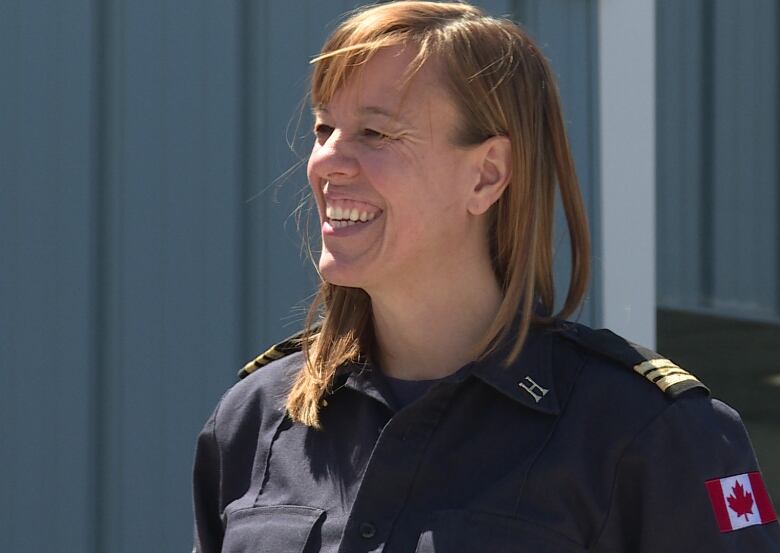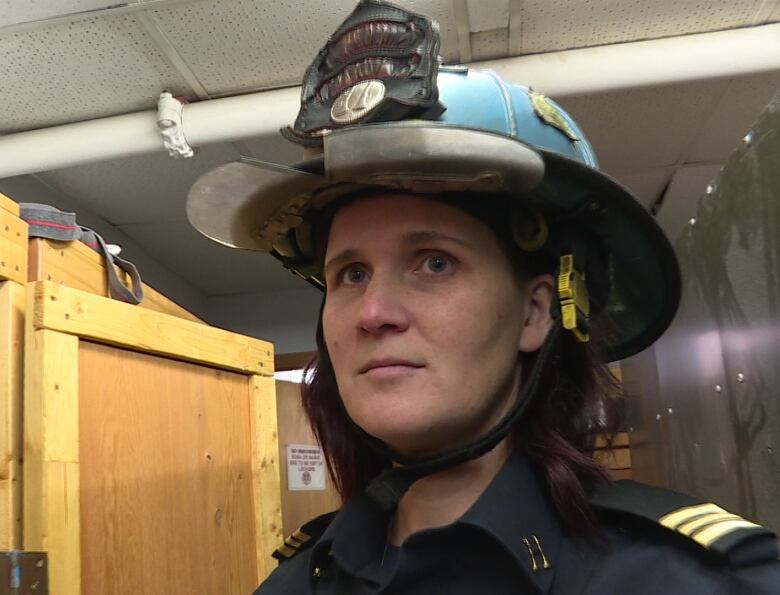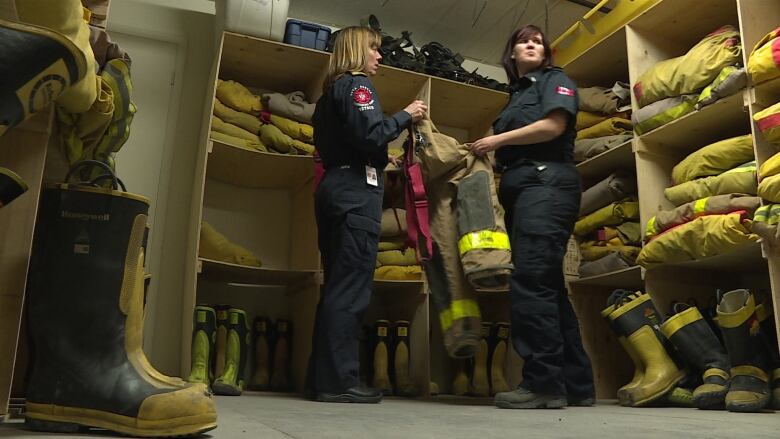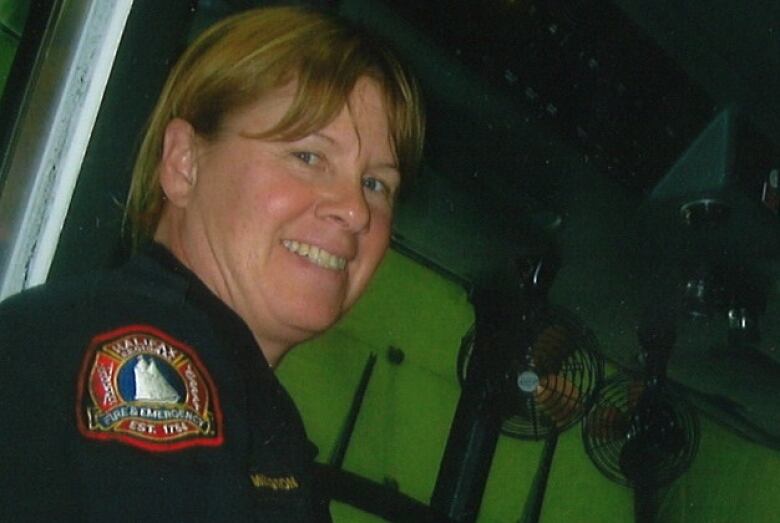'I did fear for my safety': Female Halifax firefighters describe harassment on the job
Former firefighter has filed a complaint with the Nova Scotia Human Rights Commission

Some female firefighters within the Halifax Regional Fire Department allege they have been bullied and harassedbecause of their gender.
They describe a toxic workenvironment, abusive behaviour, and being devalued and demeaned by their male colleagues.
"You never are a part of it. You'll never be a part of it. You think you are but you're not. You're a woman working with men," says Kathy Symington, aformer Halifax firefighter who was one of just a few womenin her station when she was hired in 1997.

Symington saysshe was the target ofinappropriate comments and sexual harassment from her colleagues.
"Do you like oral sex, who's your favourite sexual partner? Things like that," she says.
'I was scared'
Symington says she could handle the comments, but then her car was vandalized.
She believes a male co-worker from her station smashed the windows in her car three times within a yearwhile it was parked outside the station.
"I didn't understand why I was being targeted. I was scared, terrified actually," says Symington.
"I did fear for my safety."
Symington says she didn't know who to trust while on the job, fightinga fire.
"You have a career that you're supposed to trust people with your life if it came down to it," she says. "But you can't even trust them to deal with your basic human rights of being able to work in a workplace free of harassment."
Symington says she eventually left the service after filing a complaint that was ruled unfounded by the city's human resources department.
Shefiled a new complaint with the Nova Scotia Human Rights Commission in April 2016.
The Human Rights Commission said in May that it isalso holding an inquiry into claims of systemic gender discrimination within the Halifax Fire Department.
A lonely experience
Nine per cent of firefighters in Halifax are women, about 90 womenout of of one thousand firefighters.
Lynelle Vetsch, a senior fire instructor at the Nova Scotia Fire School, was one of the first female volunteers at Station 65 in Tantallon. She describes the experience as lonely.

She says it was awkward, dealing with issues around shared sleeping quarters and bathrooms.
"I remember being in one station that had a unisex bathroom and the door did not lock," says Vetsch. "And the captain was really concerned when he had a woman come to his station for the first time."
Entering the 'boys club'
Jennifer MacKinnon was the first woman to signup as a volunteer firefighter at a stationin rural Cape Breton in 2009. MacKinnon says it was months before she received a call about her applicationand was interviewed.
I was told they did everything to try to keep us out and we got through it anyway.-KathySymington
"They were wondering how to handle it because they never had any women," says Mackinnon. "I was entering a boys club, so to speak."
MacKinnon says her interview lasted much longer than her male counterparts.
"Some of the questions were, 'Do you have a relationship? Are you married? Why are you here? Can you wear a pack,is that too heavy for you? Do you think you can handle this?'"
Kathy Symington says she was one of eight women at her station when she began her career.
"They gave us oversized gear and I was told they did everything to try to keep us out and we got through it anyway," Symington says.
'Not part of the crew'
Symington and others describe subtle behaviours which left them out too. Menwould leave the room when they entered, question or devalue their abilities, or simply not allow them to participate.
Lynelle Vetsch says she was often told to stay in the truck while the men worked the fire.
"The first time it happened I was devastated and I sat there, fighting back tears because I didn't know why he didn't want me to get off the truck," says Vetsch.
"I felt really isolated, certainly not a part of the crew, certainly disliked.It was really hard."
Speaking out
Symington, Vetschand MacKinnon say it's difficult for women to speak outabout harassment.
"I know women who have had things done to them, that you know, they've been touched inappropriately and they will not take it forward," says Vetsch.
"It makes me sick to my stomach. These women just want to pursue a career or they want to volunteer in their community and do something positive."

Symington says after she filed a complaint, her own credibility was called into questionand the harassment got worse.
Workplace complaints
The Halifax Regional Fire Department has been the subject of 14 workplace rights complaints and four human rights complaints since 2008. Those complaints could include all types of grievances, not only from women.
Eight of the workplace rights complaints dealt with personal harassment, and threedealt with a "poisoned workplace." One of the 14 complaints identified gender discrimination.
Phil McNulty, executive officer for Halifax Regional Fire,admits it can be hard to speak out.
"That's difficult to do," says McNulty. "Often times the right thing to do is the hardest thing to do. We're trying to make it as easy and comfortable as we possibly can."
McNulty says the number of complaints is to be expected when there is a workforce of a thousand people working in close quarters.

Education is key
McNulty says diversity training is now a key component in firefighter training, and educating firefighters is the best way to solve the problem.
"Our learning evolves," says McNulty. "Things that I didn't know were offensive 20 years ago, I now, would never utter. So a lot of these are solved through education."
"Often times complaints arise from people making comments that at the time they didn't know were inappropriate."
More progress needed
Lynelle Vetsch agrees that things are improving for women firefighters,but the situation still needs work.
"It's incorrect to say that things are as far as they need to go for women in the fire service," she says."
"You still have to prove yourself that little bit more because you're a woman, and you do have to have a really thick skin to get ahead and to stay in this business."












_(720p).jpg)


 OFFICIAL HD MUSIC VIDEO.jpg)
.jpg)



























































































